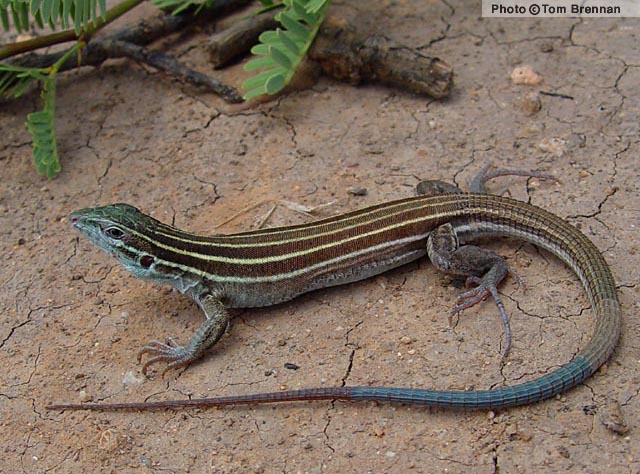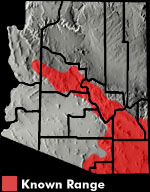Online Field Guide to The Reptiles and Amphibians of Arizona



Cochise County, AZ
| DESERT GRASSLAND WHIPTAIL Aspidoscelis uniparens | |
|
DESCRIPTION: A small (up to 86 mm or 3.3″ from snout to vent), slim, dark brown lizard with a long, thin tail, and a slim, pointed snout. The body is marked with six yellow to cream stripes. Some individuals have a partial seventh stripe on the top of the neck. The tail is a muted blue-gray or olive color. The underside is plain and pale. Some adults have a faint pale-blue tint on the throat and sides of face. Juveniles have a bright blue tail. The scales on the body are small and granular. The scales on the tail are large, keeled, and rectangular. The belly scales are large, smooth, and rectangular. The scales on top of the head are large, smooth, and plate-like. Its lack of spots distinguishes this lizard from many Arizona whiptails. Its relatively muted tail coloration distinguishes it from the similar looking Plateau Striped Whiptail. Its muted tail coloration combined with a lack of blue coloration on the feet and underside distinguish it from the Arizona Striped Whiptail and Pai Striped Whiptail. HABITAT: Primarily an inhabitant of Semidesert Grassland but also follows drainages up into Interior Chaparral and the woodland communities. Frequents low valleys, mesquite-lined riparian corridors, floodplains, and moderate slopes. It is often encountered in disturbed areas and may be expanding its range as a result of overgrazing. BEHAVIOR: This is an alert, diurnal, fast-moving ground-dweller. It is often encountered foraging or basking in the mid-morning or late afternoon sun. It hibernates during the cold months of fall and winter. DIET: It actively forages by rooting around in organic matter under bushes and by digging in the soil around the bases of rocks and other surface debris. It feeds on termites and other insects. REPRODUCTION: All Desert Grassland Whiptails are female (parthenogenetic). Eggs are unfertilized and hatchlings are clones of the mother. Two or three clutches of eggs are laid in spring and summer. Clutch size ranges from 1 to 4 eggs. By Thomas C. Brennan Brennan, T. C., & A. T. Holycross. 2006. A Field Guide to Amphibians and Reptiles in Arizona. Arizona Game and Fish Department. Phoenix, AZ Brennan, T. C., & A. T. Holycross. 2005. A Field Guide to Amphibians and Reptiles of Maricopa County. Arizona Game and Fish Department. Phoenix, AZ Stebbins, R.C. 2003. A Field Guide to Western Reptiles and Amphibians, Third Edition. Houghton Mifflin Company, Boston, MA. |
|
Visit Partners in Amphibian and Reptile Conservation:


HOME
Copyright © 2023, Arizona Game and Fish Department. All rights reserved.
If you make use of the textual contents of this site in reports, publications, etc. please cite and credit the author(s) and photographer(s). All photos on this website are copyrighted. However, those found in the species account section may be used for any noncommercial scientific, educational, or conservation purposes provided that photographs are not altered and continue to bear the copyright symbol and name of the photographer. Please contact the photographer regarding commercial use of copyrighted photographs.










